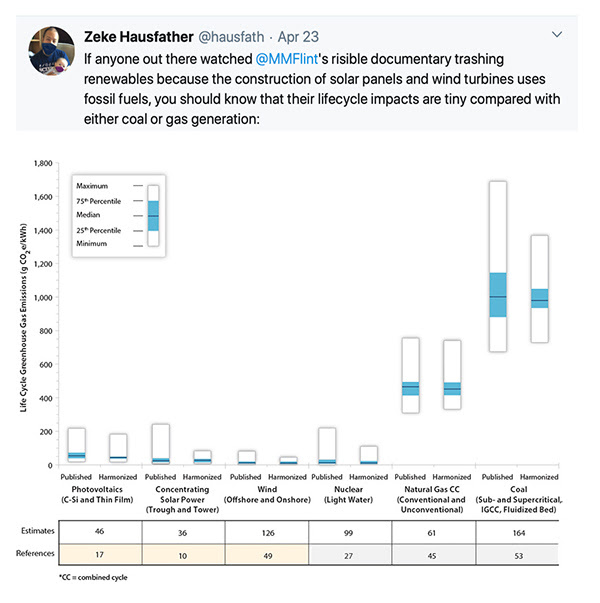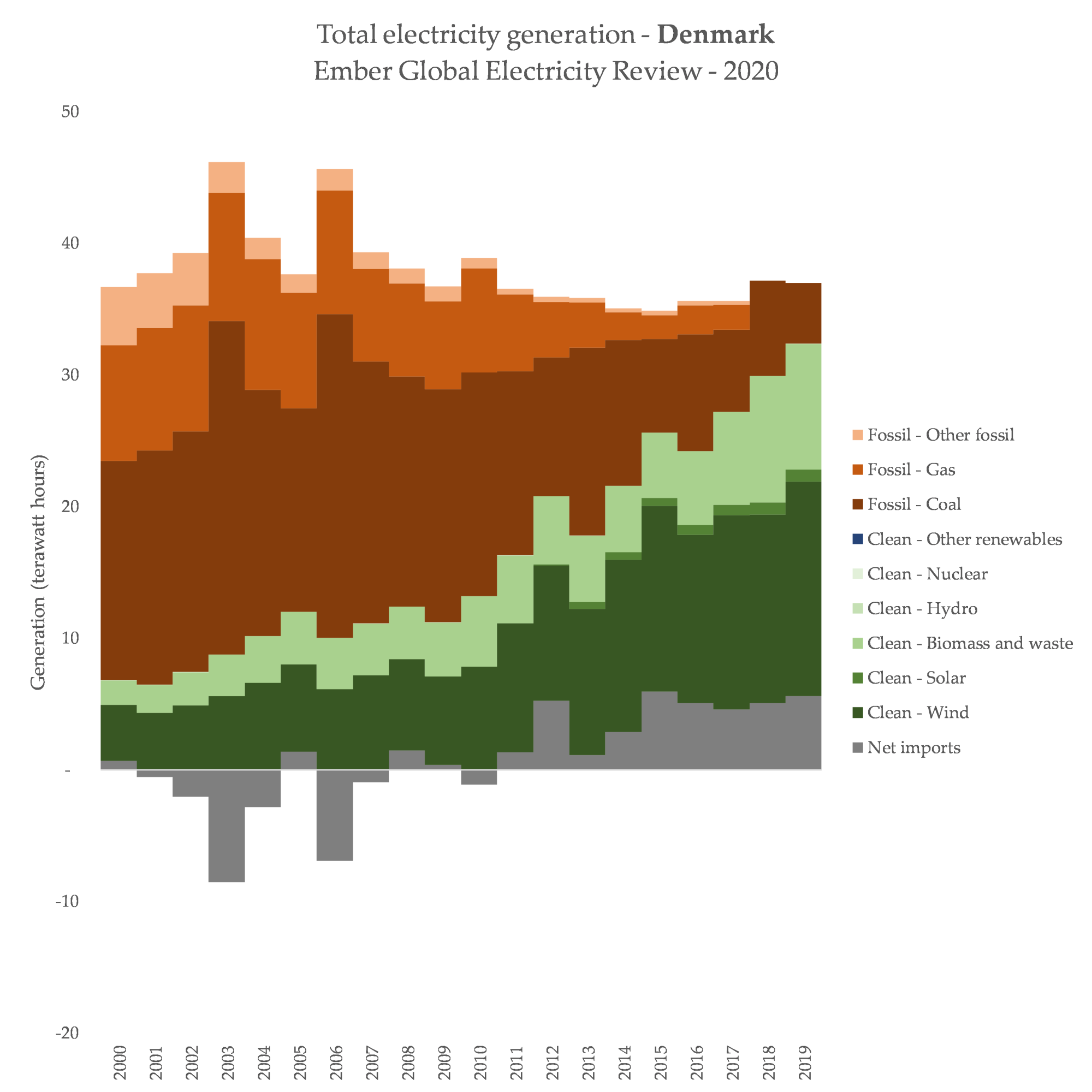Planet of the Humans—Is This the Best They’ve Got?
I have learned that “include” is p.r.-ese for “here is everything we’ve got, and then some.”
— Andrew Tobias, The Funny Money Game
The Michael Moore documentary, Planet of the Humans, has now got over five million views, and the exasperated debunkings have been pouring in. However, their litany of green energy whines has been pretty much a dribble, with nitpicks about 8% efficient solar panels, panels that only last 10 years, a deserted solar desert, soon to be resolared, biomass that’s reached critical biomass, solar, wind, batteries, electric car charging grids, all from ten years ago… and that’s about it for energy nitpicks. I can’t continue with blah, blah, blah, because there’s not that much Moore to blah, blah, blah about.
There is one more point they have, which is more substantial than a nitpick. The fossil fuels used to make solar and wind farms do not negate their CO2 savings. This is described very well in Canadian 100% RE gadfly Blair King’s excellent, even handed review:
The Michael Moore documentary, Planet of the Humans, has now got over five million views, and the exasperated debunkings have been pouring in. However, their litany of green energy whines has been pretty much a dribble, with nitpicks about 8% efficient solar panels, panels that only last 10 years, a deserted solar desert, soon to be resolared, biomass that’s reached critical biomass, solar, wind, batteries, electric car charging grids, all from ten years ago… and that’s about it for energy nitpicks. I can’t continue with blah, blah, blah, because there’s not that much Moore to blah, blah, blah about.
There is one more point they have, which is more substantial than a nitpick. The fossil fuels used to make solar and wind farms do not negate their CO2 savings. This is described very well in Canadian 100% RE gadfly Blair King’s excellent, even handed review:
The reality is that any number of well-researched life cycle analyses demonstrate conclusively that solar PV installations can quickly make up the carbon debt generated in their production and produce effective, if intermittent, electricity. Moreover, the vast majority of solar facilities are solar PV and therefore most of the critiques presented do not apply. Yes, the panels do rely on scarce resources and are hard (and often extremely expensive) to recycle and building them in deserts harms the environment, but the life cycle analyses don’t lie. Solar PV is a a valuable source of low-carbon electricity as part of an integrated grid.The arguments about wind are equally weak. Yes wind is intermittent and yes wind turbines typically are sited in locations that have lots of wind. But all energy generation has trade-offs and the life cycle analyses support wind turbines as well. Modern wind, like modern PV solar, makes absolute sense in a well-designed renewable energy mix.
I will say that IMO, Blair is soft on wind and solar. They still take up lots of space and compete with nuclear for scarce funding and resources, such as pumped storage. It’s extremely doubtful they can come anywhere near the 80% of electricity generation in France.
From the outraged greens, there also seem to be a lot of low resolution, hard-to-read graphs. The Climate Crocks guy has a post with a nice selection.

The flattening green wedge in this one looks sort of like a door stop.

The South Australia one does not have any delineation for the growing green renewables band. It has light blue colors for their much-touted grid batteries that are nowhere to be found on the graph itself. (Perhaps with a microscope?)

There’s a tweeted graph by Zeke Hausfather with no link or clue about how to read it.

You’d think they could better match block and text size.
We all know about Josh Fox’s tweeted letter, which includes lots of typos, Michael Mann as a signatory and a link to Mark Jacobson’s (also a signatory) peer reviewed New York plan, with its 387X100MwCSP grid resiliency. He also has a long fiery rant in the Nation.
Of all the videos I found, this one was interesting, with an auburn haired woman, who looks too pale to have freckles, lamenting the lack of people of color (about 10 minutes in). Perhaps she missed the African cobalt mine.
Of all the videos I found, this one was interesting, with an auburn haired woman, who looks too pale to have freckles, lamenting the lack of people of color (about 10 minutes in). Perhaps she missed the African cobalt mine.
As Charlton Heston said in Planet of the Apes, “Look at the bright side. If this is the best they’ve got around here, in six months, we’ll be running this planet.”
The telling graph on Denmark (which you comment there is no clue to understand it) is the grey part labelled “net imports”. What that shows is that Denmark is just part of a supergrid, so can import or export power whenever there is an inbalance. This shows just how they need somewhere/one else to provide the balance. The grid can only have a lot of unreliables on it because it is just a small part of a larger unit. It does NOT prove you can run a country on renewables. In fact it proves just the opposite. Same with South Australia. And they don’t even mention where they get their inertia from – but that is another thing behind the green curtain
LikeLiked by 1 person
The thing that impressed me most about that Denmark graph was how hard it is to read the color legend. Now that I’ve put a little effort into it, I see that the light green biomass (most likely dispatchable) has sort of expanded at a similar rate as the fossil fuels have contracted.
LikeLike
Ouch is too mild. Those little kids squatting over horrific industrial waste, in or around which they are forced to labour. Thank you for making this point – and for joining the Cliscep team.
LikeLiked by 2 people
As Chris mentioned, South Australia has had to go to some lengths to ensure grid stability. The following is for anyone who does not yet know all about the marvels of South Australia’s grid:
LikeLiked by 1 person
Regarding Zeke’s point about lifecycle analysis. I have read other analysis that says solar PV does not break even at latitudes like the UK’s. If I recall right, the study was based not on the claims made in manufacturers’ brochures, but in real world PV performance in ?Switzerland/Germany?
It’s obvious that PV would work wonders in Very Hot places that run air conditioners in the daytime when it is Very Hot. In the UK, PV would be quickly driven off the stage by a barrage of rotten fruit, ‘cept it is shielded by moral necessity.
LikeLiked by 1 person
Denmark is lucky in being situated on a peninsular so off shore wind is easy to site. They have taken advantage of this at some detriment to their bird population. As a small country they do have problems with siting. With a small population with no heavy industry they do not have to produce a lot of energy.
Even then though they import 8% from abroad including nuclear which is banned there.
They have resources of oil and gas but export these CO2 producing fuels. They still use some coal too.
I do hope they do not commit to much to imported wood chips which is a scam world wide.
Larger countries with heavy industry need much bigger reliable base loads such as the new clean coal station built in Germany recently needed because they closed their nuclear stations prematurely.
LikeLiked by 1 person
JIT says: It’s obvious that PV would work wonders in Very Hot places that run air conditioners in the daytime when it is Very Hot.
Obvious perhaps, but wrong – solar panels don’t like it hot.
It may seem counter-intuitive, but solar panel efficiency is affected negatively by temperature increases.
https://www.cedgreentech.com/article/how-does-heat-affect-solar-panel-efficiencies
LikeLiked by 1 person
Oldbrew, I suspect solar panels used out in space have to be very robust. I understand that temperatures with no intervening atmosphere can be hundreds of degrees in the Sun and down to double digit Kelvin levels in the shade.
LikeLike
The big trick the proponents of the unreliables do is to just use yearly averages in their graphs for energy produced. That smooths over their disruptive effect. What really needs to be shown in the daily composition of the energy sources, both for a day with little or no wind, and a day with an oversupply. That highlights the true effect (and is why they don’t do it) Here is an example of New Zealand’s https://www.em6live.co.nz/ look at overview page then one of the North Island regions. Note it is live so the data constantly changes There are similar ones for Australia. Their electricity market operator has realized they have major problems and just issued a new report. The easiest way to read it is in the links through here. http://www.wattclarity.com.au/articles/2020/04/aemo-renewable-integration-study/
LikeLiked by 1 person
There is one important point JIT left out in his description of synchronous condensers. They need power from the grid continuously to run them. So like batteries, they are net power consumers. That means there is a real ongoing operating cost to their use. All to replace something thermal plant provided for free. All added costs to the person paying for the electricity.
Denmark and Germany have also started to install synchronous condensers (driving flywheels to give more inertia) where windfarms are connected at the outer ends of their grid to stabilize the voltage. That can be a real problem, especially where the output of the windfarms can vary quickly over a significant range.
LikeLiked by 1 person
This could just be further fallout from PotH
H/t Charles Rotter at WUWT.
LikeLiked by 1 person
‘It’s extremely doubtful they can come anywhere near the 80% of electricity generation in France.’
Even if they did reach 80% it would only be for a limited and unpredictable period, which is useless in modern economies without an alternative on constant standby. So you would/will end up with dual power systems at vastly increased cost compared to the original ones.
LikeLiked by 2 people
Canman – yes, solar panels in space do have to be very robust. That’s why they don’t use domestic-type ones.
‘Solar technology for space can be very expensive. A state-of-the-art solar cell can cost NASA hundreds of dollars, compared to a couple bucks for a terrestrial cell.’
https://www.solarpowerworldonline.com/2016/03/kind-solar-panels-nasa-use/
LikeLiked by 2 people
Another Climategate of damning emails on its way? Michael vs Michael: Mann attacks Moore as Russian Stooge. Sorry I’m just channeling WUWT at the moment!
LikeLike
While searching for news about whether Mark Jacobson (name-checked in another thread) had paid the defence fees after his aborted attempt to sue a scientist who disagreed with him, I came across a long article about the attacks on Planet of the Humans, so I thought I’d post a link here. It contains a veritable spiderweb of money flows from the gigarich (as touched upon in the documentary itself).
The appearance of virtue is more important than virtue itself. But if you want to trump merely displaying the appearance of virtue while hiding your sins, you can advance on to talking the talk of green platitudes while very obviously walking the walk of greed and environmental destruction. By which I mean the appearance of virtue becomes gossamer-thin, and does not resist the most cursory examination. If anyone could bother to examine it, and if their conclusions were not too distasteful to be widely disseminated, that is.
Look at those grants and weep, ye fossil-fuel-loving losers!
https://thegrayzone.com/2020/09/07/green-billionaires-planet-of-the-humans/
LikeLiked by 3 people